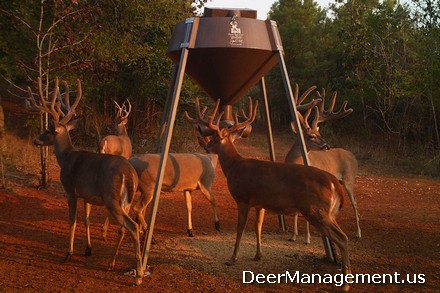Question: “My brothers and I have been whitetail deer hunting together for over two decades now and we, along with some friends, finally have a deer lease that is big enough to implement a whitetail deer management program on. We’ve been on this place for four years now. Our deer lease is 7,000 acres in size and is located in southeast Kansas. We will be starting a feeding program in January and plan on putting eight 300 pound protein feeders on the property. What percent of protein would you suggest for whitetail deer, and can you give me an idea of the amount of antler gain we can expect to see down the road?
Two years ago we have adopted a 3.5 year old minimum buck age and have gone from taking bucks in the 13’0s to bucks in the 150’s. Do you think this is okay or should we raise the minimum deer age or set a minimum antler score? Thanks!”

Answer: First off, let me say that it sounds like you have got a great situation for both deer hunting and the ability to grow bigger bucks! A ranch of 7,000 acres will allow you to comfortably conduct deer management for whitetail deer. White-tailed deer require a minimum 16 percent protein diet for optimal nutrition, so I would recommend the free-choice feeding of protein pellets with a minimum 16 percent protein. Can you feed a 20 percent protein? Yes, but I recommend going with 16 percent. The extra 4 percent protein will not deliver noticeably different results, except to your pocket book.
Supplemental feeding will definitely increase antler growth in bucks. Many hunters mistaken feed protein pellets just to increase antler growth. Yes, protein has this result, but the herd benefits far outweigh just antler growth. A simpler, less expensive way to increase antler growth is just to let bucks get one year older. That said, feeding protein will benefit the deer found on your ranch immensely. An increase in antler growth will be noticed by bucks in each age class, but does will also be healthier and will recruit more fawns into the deer herd.
The benefit of feeding protein for bucks, as in the additional inches of antler per buck, will vary from property to property. This is because other factors come into play. These factors can include overall habitat quality, habitat condition (precipitation related), age composition of the buck herd, deer density, genetic potential of bucks and the ranch’s buck to doe ratio. Most ranches that offer free-choice protein pellets between January and September can expect to see an additional 10 to 20 inches of antler growth per buck over unfed bucks of the same age.
Addressing your question about minimum age and deer hunting, a 3.5 year old buck has a lot of potential for increased antler growth. Deer complete their skeletal long bone growth at about 3 years of age. During the first 3 years, however, much of the nutrients that would be used for antler growth are needed for skeletal growth. Once this is over, bucks typically put those additional nutrients into antler growth. This is why bucks typically make a huge jump in antler quality from 3.5 to 4.5 years of age. I would recommend implementing a minimum of at least 4.5 years of age or older for deer management for whitetail deer for this reason.
Stay away from a minimum score for buck harvest. All this will do is promote the harvest of your best bucks at an earlier age. Some of the bucks with the best potential may reach your minimum score at 2.5 years old. It would be a shame to shoot that buck at 2.5 years old if older bucks of lesser quality are running around, left to do the breeding, that may never achieve your minimum score. Use age as your criteria and judge each buck based on his antler quality for his age. In addition to the factors listed above, deer management for whitetail deer takes being able to accurately age deer on the hoof. Make sure hunters on your property know how to age deer before you turn them loose.